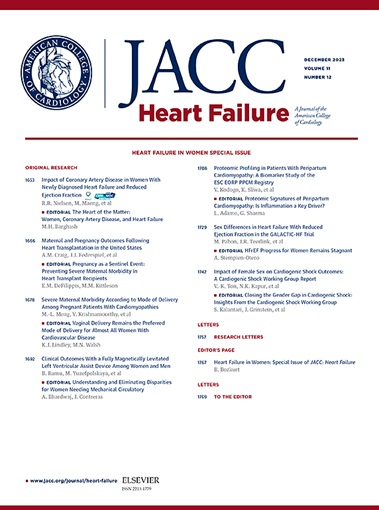Timing of Cardiac Resynchronization Therapy Following Stable Medical Therapy in Patients With Heart Failure.
IF 10.3
1区 医学
Q1 CARDIAC & CARDIOVASCULAR SYSTEMS
引用次数: 0
Abstract
BACKGROUND Guidelines' recommendations for cardiac resynchronization therapy (CRT) implantation in selected patients with heart failure (HF) exist. However, data on the best timing for CRT implantation after the achievement of stable medical therapy (SMT) and its association with outcomes are currently lacking. OBJECTIVES The aim of this study was to investigate the timing of CRT implantation after the achievement of SMT, associated patient profiles, and clinical outcomes in a real-world HF population. METHODS Patients with HF treated with SMT derived from the Swedish ICD and Pacemaker Registry who received CRT between 2007 and 2020 were included in the study. Patient characteristics associated with a shorter or longer time to CRT implantation were assessed using multivariable logistic regression, and associations between the time from SMT to CRT implantation and clinical outcomes (mortality and morbidity) were analyzed using multivariable Cox regression. RESULTS Of the 9,409 patients, 43.8% received CRT at <3 months of achieving SMT, 34.9% between 3 and 9 months, and 21.3% after 9 months. The time from SMT to CRT implantation decreased significantly over the study period. Independent determinants of shorter time to implantation included recent HF hospitalization, previous implantation of a defibrillator, and greater use of guideline-directed medical therapy, whereas a history of HF >6 months and ischemic heart disease were associated with a longer time. After adjustments, there was a 9% lower risk of cardiovascular death with a shorter time from SMT to CRT implantation of <3 months vs 3-9 months (P = 0.045). A delayed time of >9 months vs 3-9 months was associated with a 13% higher risk of cardiovascular death/HF hospitalization, a 12% higher risk of cardiovascular death (P = 0.040), and an 11% higher risk of first HF hospitalization (P = 0.013). CONCLUSIONS Time from the achievement of SMT to CRT implantation decreased over the study period. Delayed CRT implantation beyond 3 months was associated with higher cardiovascular mortality compared with earlier implantation after GDMT optimization.心衰患者稳定药物治疗后心脏再同步化治疗的时机
背景:心脏再同步化治疗(CRT)植入心力衰竭(HF)患者的指南推荐存在。然而,目前缺乏稳定药物治疗(SMT)后植入CRT的最佳时机及其与预后的关系的数据。目的:本研究的目的是调查在实现SMT后CRT植入的时机,相关的患者概况和现实世界HF人群的临床结果。方法纳入2007年至2020年期间在瑞典ICD和起搏器登记处接受SMT治疗的HF患者。使用多变量logistic回归评估与CRT植入时间较短或较长相关的患者特征,并使用多变量Cox回归分析从SMT到CRT植入时间与临床结果(死亡率和发病率)之间的关系。结果9409例患者中,43.8%的患者在6个月时接受了CRT治疗,缺血性心脏病的相关时间较长。调整后,从SMT到CRT植入的时间较短,9个月与3-9个月相比心血管死亡风险降低9%,心血管死亡/HF住院风险增加13%,心血管死亡风险增加12% (P = 0.040),首次HF住院风险增加11% (P = 0.013)。结论从SMT完成到CRT植入的时间在研究期间缩短。延迟CRT植入超过3个月与GDMT优化后早期植入相比,心血管死亡率更高。
本文章由计算机程序翻译,如有差异,请以英文原文为准。
求助全文
约1分钟内获得全文
求助全文
来源期刊

JACC. Heart failure
CARDIAC & CARDIOVASCULAR SYSTEMS-
CiteScore
21.20
自引率
2.30%
发文量
164
期刊介绍:
JACC: Heart Failure publishes crucial findings on the pathophysiology, diagnosis, treatment, and care of heart failure patients. The goal is to enhance understanding through timely scientific communication on disease, clinical trials, outcomes, and therapeutic advances. The Journal fosters interdisciplinary connections with neuroscience, pulmonary medicine, nephrology, electrophysiology, and surgery related to heart failure. It also covers articles on pharmacogenetics, biomarkers, and metabolomics.
 求助内容:
求助内容: 应助结果提醒方式:
应助结果提醒方式:


